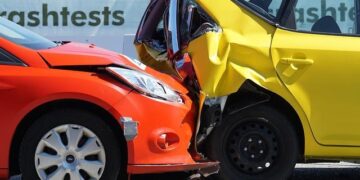Table of Contents
The Unwavering Obligation: Your Legal Duty After a Collision
In the immediate aftermath of a motor vehicle collision, a driver’s first and most fundamental legal obligation is to stop.
This duty is absolute, forming the cornerstone of traffic law across every U.S. state, and it exists entirely independent of who may have been at fault for the accident.1
The law’s primary objective in these initial moments is not to determine liability but to prevent flight and ensure human welfare.
This principle is evident in the fact that the failure to stop is itself a serious offense, separate from any traffic violation that may have caused the crash.3
The Universal Mandate to Stop
Every state requires drivers to stop their vehicle at the scene of an accident, or as close as is safely possible, when the collision involves property damage, injury, or death.2
This act of stopping is non-negotiable.
Fleeing the scene is legally defined as a “hit-and-run,” a term that carries significant criminal weight.1
The offense is not a simple traffic ticket but a criminal charge that can range from a misdemeanor to a felony, depending on the severity of the accident.2
This legal framework underscores that a driver’s first test is one of responsibility—staying, rendering aid, and reporting—rather than a premature debate over fault on the roadside.
It is a crucial point that even a driver who is the victim of a hit-and-run must report the accident, as failing to do so could expose them to an accusation of the very same offense.7
Duty Irrespective of Fault
The legal requirement to stop and exchange information applies to all drivers involved in the collision, without regard to who is at fault.2
The immediate legal concern is not assigning blame but securing the scene, ensuring that any injured parties receive assistance, and establishing a clear path for financial responsibility through the subsequent insurance claims process.2
Duty to Render Aid
Beyond the exchange of information, drivers have an affirmative legal duty to provide “reasonable assistance” to anyone injured in the crash.2
In most circumstances, this duty is fulfilled by promptly calling 911 to request emergency medical services.2
This humanitarian requirement is a core purpose of the laws that mandate remaining at the scene, prioritizing the well-being of those involved above all else in the initial moments following a collision.12
The Anatomy of an Exchange: A Comprehensive Information Checklist
The process of exchanging information after a collision is a critical exercise in both legal compliance and strategic self-preservation.
While state laws mandate the exchange of certain core details, legal and insurance experts advise gathering a more comprehensive set of information to build a robust record and protect against potential disputes or fraud.13
The information exchange should be viewed not as a passive act of compliance, but as an active process of evidence collection.
Legally Required Information (The “Must-Haves”)
State laws universally require the exchange of a specific set of foundational details.
Failure to provide this information can lead to legal penalties.
The essential items include:
- Personal and Contact Details: Your full name and current residential address.1
- Driver’s License Information: You must be prepared to show your driver’s license and provide the license number upon request.1
- Vehicle Registration: The vehicle’s registration number must be shared, along with the name and address of the vehicle’s registered owner if they are not the driver.11
- Proof of Financial Responsibility (Insurance): This is the cornerstone of the exchange. You must provide the name of your insurance company and your policy number.1
Strategically Essential Information (The “Should-Haves”)
To fully protect your interests, the exchange should go beyond the legal minimum.
The following details are strategically vital for a smooth claims process and for defending against potential future disputes:
- Direct Contact Information: Obtain the phone numbers and email addresses of all drivers and passengers involved.11
- Detailed Vehicle Information: Note the make, model, year, and color of all vehicles. Critically, record the Vehicle Identification Number (VIN), as it is the most precise way to identify a specific vehicle.11
- Witness Information: If there are any witnesses to the collision, collect their names and contact information. Their impartial account can be invaluable if liability is disputed. It is not necessary to take a formal statement at the scene; simply securing their contact details for future follow-up is sufficient.13
- Law Enforcement Details: If police respond to the scene, obtain the name and badge number of each responding officer and ask for the police report number. This report will be a key document for your insurance claim.14
- Scene Documentation: Note the exact location of the accident, including street names, cross-streets, and any nearby landmarks. Also record the date, time, and prevailing weather and road conditions.14
The Modern Best Practice: Photographic Documentation
In the high-stress environment of an accident scene, memory can be unreliable and handwriting prone to error.
The most effective and accurate method for gathering information is to use a smartphone camera.13
- Documenting Paperwork: Take clear, legible photographs of the other driver’s license, vehicle registration card, and insurance card. This creates an indisputable digital record and is the best defense against being provided with false or inaccurate information.13
- Documenting the Scene: Take extensive photos of the accident scene from multiple angles. Capture the damage to all vehicles, the final resting positions of the cars, license plates, and any relevant environmental factors like traffic signals, road signs, or skid marks.14
The following checklist provides a structured guide to ensure all critical information is gathered.
| Post-Accident Information Exchange Checklist | |
| Information from Other Driver(s) | Check When Complete |
| Full Name and Current Address | ☐ |
| Phone Number and Email Address | ☐ |
| Driver’s License Number and State of Issuance | ☐ |
| Date of Birth | ☐ |
| Information for Their Vehicle(s) | |
| Make, Model, Year, and Color | ☐ |
| License Plate Number and State | ☐ |
| Vehicle Identification Number (VIN) | ☐ |
| Registered Owner’s Name and Address (if different from driver) | ☐ |
| Information for Their Insurance | |
| Insurance Company Name and Phone Number | ☐ |
| Policy Number | ☐ |
| Name of the Policyholder | ☐ |
| Witness Information | |
| Full Name(s) of Any Witnesses | ☐ |
| Phone Number(s) and/or Email Address(es) of Witnesses | ☐ |
| Accident Scene Details | |
| Date and Time of the Accident | ☐ |
| Exact Location (Street, City, Cross-Street/Landmark) | ☐ |
| Responding Police Officer’s Name and Badge Number | ☐ |
| Police Report Number | ☐ |
| Photos of All Vehicle Damage, License Plates, and the Scene | ☐ |
The High Stakes of Non-Compliance: Civil and Criminal Ramifications
Failing to stop and exchange information after an accident carries significant consequences that span criminal law, civil liability, and insurance administration.
The legal framework is designed as an escalating system of incentives and punishments.
It provides a relatively minor penalty for a driver who makes a procedural mistake but otherwise acts responsibly by remaining at the scene.
However, it imposes severe criminal penalties for those who choose to flee, especially when another person is injured.
This structure is not arbitrary; it is a deliberately constructed system designed to compel a specific, responsible course of action by making the alternative—fleeing—catastrophically risky.23
The Spectrum of Penalties
The penalties for non-compliance exist on a spectrum, determined by the driver’s actions and the accident’s outcome.
- Infractions for Failure to Exchange: In some jurisdictions, the simple failure to provide the required information while remaining at the scene is a lesser offense. For instance, California Vehicle Code 16025 classifies this as an infraction, punishable by a fine of up to $250 plus court fees, without assessing points on the driver’s record.25
- Misdemeanor Hit-and-Run (Property Damage): Leaving the scene of an accident that involves only property damage is typically charged as a misdemeanor.2 Penalties often include significant fines (e.g., up to $1,000 in California), potential jail time (up to six months in California), and the assessment of points against the driver’s license.6
- Felony Hit-and-Run (Injury or Death): The charge escalates to a felony if a driver leaves a scene where another person has suffered any injury or has been killed.3 This is the most serious charge, carrying severe penalties that can include years in state prison (e.g., up to four years in California), substantial fines (e.g., up to $10,000 in California), and long-term revocation of driving privileges.23
Insurance and Civil Consequences
Beyond the courtroom, the ramifications of non-compliance extend to insurance coverage and civil lawsuits.
- Insurance Complications: Insurance companies require prompt and accurate information to process claims. Without the other party’s details, filing a claim becomes difficult, leading to significant delays or even outright denial of coverage.6 Furthermore, failing to report an accident as required by a policy can be considered a breach of the insurance contract, potentially leading to policy termination or non-renewal.6
- Civil Liability: A driver who flees the scene can still be sued for damages. The act of fleeing is often used in civil court as powerful evidence of “consciousness of guilt,” making it significantly more difficult for the driver to defend against liability for the victim’s medical expenses, lost wages, and vehicle repair costs.6
The following table provides a comparative overview of the severe penalties for leaving the scene in several states, illustrating the escalating consequences based on the severity of the accident.
| Penalties for Leaving the Scene: A Comparative Overview | |||
| Jurisdiction | Triggering Event | Offense Level | Potential Penalties |
| California 24 | Property Damage Only | Misdemeanor | Up to $1,000 fine; Up to 6 months in county jail. |
| Injury or Death | Felony | $1,000 – $10,000 fine; Up to 4 years in state prison; License revocation. | |
| New York 27 | Property Damage Only | Traffic Infraction | Up to $250 fine; Up to 15 days in jail. |
| Personal Injury | Class A Misdemeanor | $500 – $1,000 fine; Up to 1 year in jail. | |
| Serious Injury / Repeat Offense | Class E Felony | $1,000 – $5,000+ fine; Up to 4 years in prison. | |
| Death | Class D Felony | $2,000 – $5,000+ fine; Up to 7 years in prison. | |
| Arizona 23 | Property Damage Only | Class 2 Misdemeanor | Up to $750 fine; Up to 4 months in jail. |
| Non-Serious Injury | Class 5 Felony | $750+ fine; 9 months to 2 years in jail; 3-year license revocation. | |
| Serious Injury or Death | Class 3 or 2 Felony | $750+ fine; 2.5 to 10 years in prison; 5 to 10-year license revocation. |
Official Documentation: The Critical Role of Police and DMV Reports
Following a collision, the information exchange between drivers is supplemented by formal reporting to government agencies.
The two primary forms of official documentation are the police report and the state DMV report.
These serve distinct but complementary purposes, and understanding the requirements for each is essential to avoid legal penalties.
The existence of this dual-reporting system reflects the separate interests of law enforcement and state administration.
The police are concerned with the immediate event—public safety, traffic law enforcement, and potential criminal investigation.
The DMV is concerned with the long-term record of the driver—licensing, safety history, and compliance with financial responsibility laws.1
A driver’s assumption that reporting to one agency satisfies their duty to the other is a common and potentially costly mistake.
When to Call the Police
While it is always advisable to call the police to create an official record, it is legally mandatory in most states under specific circumstances.29
- Injury or Death: All states require drivers to report an accident that results in any personal injury, no matter how minor, or a fatality.7
- Property Damage Thresholds: Reporting is also mandatory if the apparent property damage exceeds a state-specific monetary value. These thresholds vary dramatically, from as low as $500 in states like Florida and Georgia to $2,000 or more in others like Alaska.29
A police report provides an impartial, official account of the incident that is highly valued by insurance adjusters when determining fault.6
The absence of a report can raise skepticism and complicate the claims process.30
The Driver’s Report to the DMV
In addition to any police report, many states require drivers to file a separate accident report directly with the Department of Motor Vehicles (DMV) or an equivalent agency.5
- Driver’s Responsibility: This report, such as California’s Form SR-1 or New York’s Form MV-104, is the driver’s responsibility. The fact that law enforcement filed a report does not absolve the driver of this separate duty.1
- Triggers and Deadlines: The requirement to file a DMV report is typically triggered by the same injury or property damage thresholds that mandate calling the police. However, there is a strict deadline for filing, often within a short period like 10 days of the accident.1
- Consequences of Failure: Failing to file a required DMV report is a serious matter that can lead directly to the suspension of one’s driver’s license.1
The following table highlights the significant variation in reporting requirements across several states.
| State-by-State Accident Reporting Thresholds | ||
| State | Accident Must Be Reported If There Is: | Deadline |
| California 1 | Death, injury, or property damage more than $1,000. | 10 days |
| Colorado 29 | Death, injury, or any property damage. | 10 days |
| Florida 29 | Death or injury; property damage more than $500. | As soon as possible |
| Georgia 29 | Death, injury, or property damage more than $500. | Immediately |
| Illinois 10 | Death or injury to any person. | Within 10 days |
| Nevada 29 | All crashes. | Immediately |
| New York 5 | Death, injury, or property damage more than $1,000 to any one person. | 10 days |
| Oregon 7 | Injury or death; >$2,500 damage to any vehicle/property; vehicle is towed. | 72 hours |
| Pennsylvania 29 | Death, injury, or if a vehicle is disabled and requires towing. | 5 days |
| South Carolina 29 | Death, injury, or property damage more than $1,000. | 15 days |
| Texas 29 | Death, injury, or property damage more than $1,000. | Immediate (death/injury) or 10 days (property damage) |
| Washington 29 | Death, injury, or property damage more than $700. | 4 days |
Navigating Complications: A Strategic Guide to Difficult Scenarios
While the standard information exchange is a cooperative process, drivers must be prepared for situations where it breaks down.
When one party becomes uncooperative, uninsured, or deceptive, the dynamic shifts.
The burden of action falls entirely on the compliant driver, who must pivot from a strategy of mutual exchange to one of unilateral evidence gathering and escalation.
The Uncooperative or Aggressive Driver
If another driver refuses to provide information or becomes aggressive, personal safety is the top priority.
- Stay Calm and Disengage: Do not argue or engage in a confrontation. If you feel threatened, create distance between yourself and the other driver.4
- Call 911 Immediately: Inform the emergency dispatcher that a driver involved in the accident is refusing to cooperate or is acting aggressively. The arrival of a law enforcement officer is the most effective means of compelling compliance and de-escalating the situation.19
- Gather Evidence Unilaterally: While waiting for the police, use your phone to document as much as you can. The single most important piece of evidence to capture is a clear photo of the other vehicle’s license plate. Also try to photograph the driver and their vehicle.9
- Inform the Police: When officers arrive, provide them with a calm, factual account of the other driver’s refusal to exchange information.26
The Uninsured or Underinsured Driver
Discovering the other driver lacks insurance can be alarming, but a methodical approach is key.
- Call the Police: It is critical to have an official police report that documents the other driver’s uninsured status. This report will be essential for your insurance claim.36
- Do Not Accept Cash: The uninsured driver may offer you cash at the scene to avoid legal trouble. Politely decline. It is impossible to know the full extent of your damages and injuries in the moment, and any amount offered will almost certainly be insufficient.36
- Gather All Possible Information: Even without insurance details, collect the driver’s name, address, phone number, and all vehicle information.36
- Contact Your Insurer: Notify your own insurance company immediately and explicitly state that you were in an accident with an uninsured driver. This will trigger a specific claims process.36 Your primary tool for recovery in this situation is your own Uninsured/Underinsured Motorist (UM/UIM) coverage. This optional but critical coverage is designed to pay for your medical bills and other losses when the at-fault driver has no insurance or insufficient insurance to cover your damages.37 Without it, your only recourse is to sue the driver personally, a process that is often fruitless as individuals who drive without insurance typically lack the assets to satisfy a court judgment.37
The Deceptive Driver: Handling False Information
If you suspect a driver has provided false information, such as a fake name or an invalid insurance policy number, you must act decisively.
- Document Reliably: The best defense against false information is to gather verifiable evidence at the scene. Photographing the driver’s license and insurance card is far more reliable than writing the information down. A photo of the license plate is a crucial backup, as it can be used by investigators to identify the vehicle’s owner.13
- Report to Authorities: If you discover the deception after the fact, file a police report immediately if you have not already done so. Provide the police and your insurance company with all the evidence you gathered.39
- Engage Your Insurer: Insurance companies have dedicated fraud investigation units with resources to track down individuals using partial information. Report the suspected fraud to your claims adjuster.39
- Utilize Your UM Coverage: A driver who provides false information or who cannot be located is functionally equivalent to a hit-and-run or uninsured driver. You will likely need to file a claim under your own UM policy to cover your damages.39
A Deeper Dive into State Law: Comparative Legal Frameworks
While the overarching principles of stopping and exchanging information are universal, the specific statutes, penalties, and procedures vary by state.
Examining the legal frameworks of California, Texas, Florida, and New York reveals different legislative philosophies and procedural priorities—cultural and procedural fingerprints that shape how each state handles the same societal problem.
California
California’s legal framework is notable for its highly specific and compartmentalized statutes.
- Key Statutes: California Vehicle Code (CVC) §20001 & §20002 (Hit-and-Run), CVC §16025 (Duty to Exchange Info), CVC §16000 & §16000.1 (DMV Reporting).25
- Analysis: CVC §16025 creates a distinct, low-level infraction for the simple failure to exchange information, punishable by a fine not to exceed $250 (plus court costs), which is separate from the more serious hit-and-run offenses.25 Leaving the scene is a misdemeanor for property damage (CVC §20002) and a felony for any injury (CVC §20001).26 Drivers must also file an SR-1 report with the DMV within 10 days for any accident involving over $1,000 in property damage or any injury.1
Texas
Texas law consolidates the duties of a driver after an accident into a more cohesive set of statutes.
- Key Statutes: Texas Transportation Code §550.021 (Accident Involving Injury/Death), §550.022 (Accident Involving Vehicle Damage), §550.023 (Duty to Give Information and Render Aid).16
- Analysis: Section 550.023 explicitly lists the information to be exchanged: name, address, vehicle registration number, and the name of the auto insurance company.12 Failure to comply with these duties constitutes a hit-and-run, which is a Class C or B misdemeanor for property damage (depending on the value) and can escalate to a felony for accidents involving injury or death.16 A law enforcement officer must submit a report to the Texas Department of Transportation (TxDOT) for any crash involving injury, death, or apparent damage of $1,000 or more.34
Florida
Florida’s statutes demonstrate a greater reliance on law enforcement to manage and facilitate the information exchange process at the scene.
- Key Statutes: Florida Statutes §316.065 (Duty to Give Notice), §316.070 (Exchange of Information), §316.066 (Written Reports), §324.242 (Requesting Insurance Info).31
- Analysis: Statute §316.070 uniquely directs the responding law enforcement officer to instruct the involved drivers on what information to exchange, including name, address, vehicle license number, and the name of the liability carrier.47 Reporting to law enforcement is mandatory for crashes involving injury, death, or apparent property damage of at least $500.31 If information is not obtained at the scene, Statute §324.242 governs the formal process for requesting it from the state.46
New York
New York’s Vehicle and Traffic Law (VTL) is comprehensive and establishes a granular, tiered hierarchy of offenses for leaving the scene.
- Key Statutes: New York VTL §600 (Leaving the scene of an incident without reporting).4
- Analysis: Under VTL §600, leaving the scene of property damage is a traffic infraction.28 However, leaving the scene of a personal injury is a crime, with penalties escalating based on the circumstances. It is a Class B misdemeanor if the violation was solely a failure to exhibit documents, a Class A misdemeanor for other failures to stop, and a Class E or D felony for repeat offenses or if the accident results in serious physical injury or death.27 Separately, drivers must file an MV-104 report with the DMV within 10 days for any accident with over $1,000 in damage to any single person’s property, or any injury or death.5
Concluding Recommendations: Protecting Your Legal and Financial Interests
The legal requirement to exchange insurance information after a collision is not a mere formality; it is the critical entry point into the system of financial recovery and legal resolution.
Navigating this process successfully hinges on understanding one’s obligations, meticulously documenting the facts, and knowing how to respond to complications.
The entire post-accident protocol can be distilled into three pillars of protection.
- The Three Pillars of Post-Accident Protection:
- Preparation: The most effective actions are taken before an accident ever occurs. Drivers should ensure they carry not only the state-mandated liability insurance but also adequate Uninsured/Underinsured Motorist (UM/UIM) coverage, which serves as a crucial financial shield against irresponsible drivers.37 Keeping a current insurance card, vehicle registration, and a post-accident checklist in the vehicle can provide clarity in a chaotic moment.5
- Calm Execution: In the aftermath of a crash, adrenaline and emotions run high. The most successful outcomes are achieved by adhering to a calm, methodical process. Prioritize safety, call for emergency help if needed, and then begin the process of documenting information. It is essential to avoid discussing fault or making apologetic statements like “I’m sorry,” as these can be misinterpreted as admissions of guilt.14 A driver’s sole objective at the scene is to comply with the law and gather facts.
- Thorough Documentation: In any dispute, the party with the better documentation holds the stronger position. A smartphone is an indispensable tool for this purpose. A single, clear photograph of a license plate can be the key to a successful claim when a driver is uncooperative or flees the scene.22 Comprehensive photos of documents, vehicle damage, and the overall scene create a powerful, objective record that is difficult to dispute.
Ultimately, the exchange of information is a legal command designed to ensure order and accountability.
A driver who understands their duties, documents the facts with precision, and is prepared for complications is best equipped to protect their physical, legal, and financial well-being.
Works cited
- Vehicle Collisions – California DMV, accessed August 8, 2025, https://www.dmv.ca.gov/portal/driver-education-and-safety/educational-materials/fast-facts/vehicle-collisions-ffdl-16/
- Consequences of a Hit-and-Run Accident – Nolo, accessed August 8, 2025, https://www.nolo.com/legal-encyclopedia/consequences-hit-run-accident.html
- Leaving the Scene of an Accident/Hit and Run: State Laws – FindLaw, accessed August 8, 2025, https://www.findlaw.com/traffic/traffic-tickets/leaving-the-scene-of-an-accident-hit-and-run-state-laws.html
- Queens Car Accident Lawyer: Why Exchanging Insurance Information Is Vital, accessed August 8, 2025, https://rmfwlaw.com/blog/queens-car-accident-lawyer-why-exchanging-insurance-information-is-vital
- Chapter 12: If You Are in a Traffic Crash | NY DMV, accessed August 8, 2025, https://dmv.ny.gov/new-york-state-drivers-manual-and-practice-tests/chapter-12-if-you-are-traffic-crash
- What Happens If You Don’t Exchange Information After An Accident? – Gray Injury Law, accessed August 8, 2025, https://www.grayinjurylaw.com/what-happens-if-you-dont-exchange-information-after-an-accident-legal-risks-and-consequences/
- Reporting Requirements for Motor Vehicle Accidents | Super Lawyers, accessed August 8, 2025, https://www.superlawyers.com/resources/motor-vehicle-accidents/car-accident-liability-and-damages/navigating-reporting-requirements-for-motor-vehicle-accidents/
- Essential Information to Exchange After an Accident in California: Legal Requirements – Law Offices of David Azizi, accessed August 8, 2025, https://www.azizilawfirm.com/blog/essential-information-to-exchange-after-an-accident-in-california-legal-requirements
- Do I Have to Give My Insurance Information If Someone Hits Me in California?, accessed August 8, 2025, https://www.wccbc.com/do-i-have-to-give-my-insurance-information-if-someone-hits-me-california/
- Your Guide to Auto Accidents – Illinois State Bar Association, accessed August 8, 2025, https://www.isba.org/public/guide/autoaccidents
- What Information Should I Exchange After a Car Accident?, accessed August 8, 2025, https://www.chicagolawyer.com/blog/what-information-should-i-exchange-after-a-car-accident/
- Do I Have To Exchange Insurance Information After a Car Accident?, accessed August 8, 2025, https://tedlyon.com/do-i-have-to-exchange-insurance-information-after-a-car-accident/
- What Information to Exchange in Car Accident – Jurewitz Law Group, accessed August 8, 2025, https://www.jurewitz.com/articles/exchanging-info-after-car-accident/
- What Details Should I Share with the Other Driver After a Car Accident? – Smith & Hassler, accessed August 8, 2025, https://www.smithandhassler.com/articles/what-details-share-with-other-driver-after-car-accident/
- What to do after a car accident: a step-by-step guide – Allstate, accessed August 8, 2025, https://www.allstate.com/resources/car-insurance/in-case-of-a-car-accident
- What Information Should Be Exchanged After a Car Crash?, accessed August 8, 2025, https://www.jahlawfirm.com/blog/what-information-should-be-exchanged-after-a-car-crash/
- What Does It Mean To Exchange Information After A Car Accident? – Spencer Morgan Law, accessed August 8, 2025, https://www.smorganlaw.com/what-does-it-mean-to-exchange-information-after-a-car-accident/
- CVC 16025 – Failure to Exchange Information After an Accident | Maison Law, accessed August 8, 2025, https://maisonlaw.com/safety-laws/cvc-16025/
- What happens if you don’t exchange information after a car accident, accessed August 8, 2025, https://maguirelawfirm.com/what-happens-if-you-dont-exchange-information-after-a-car-accident/
- Is it Illegal to Not Exchange Information After a Car Accident in NY? – The Baez Legal Group, accessed August 8, 2025, https://baezlegal.com/blog/what-information-should-i-exchange-with-the-other-driver-after-a-car-accident-in-new-york/
- Were you in a wreck? Tips for auto insurance claims – Texas Department of Insurance, accessed August 8, 2025, https://www.tdi.texas.gov/tips/what-to-do-after-a-wreck.html
- A Comprehensive Checklist on How to Document Your Car Accident – The Cochran Firm, accessed August 8, 2025, https://www.cochranfirm.com/philadelphia/practice-areas/philadelphia-car-accident-lawyer/checklist-how-to-document-car-accident/
- Leaving the Scene of an Accident in Arizona | The Hamp Law Offices, accessed August 8, 2025, https://www.hamplaw.com/leaving-the-scene-of-an-accident-in-arizona
- Fleeing the Scene of an Accident in California: Complete Guide, accessed August 8, 2025, https://feherlawfirm.com/fleeing-the-scene-of-an-accident-in-california-complete-guide/
- § 16025 VC – Failure to Exchange Info After an Accident – Shouse Law Group, accessed August 8, 2025, https://www.shouselaw.com/ca/blog/insurance/does-california-law-require-you-to-exchange-insurance-information-after-an-accident/
- Do You Have to Exchange Insurance Information After an Accident in California?, accessed August 8, 2025, https://www.injuryjusticeattorney.com/exchange-of-information-after-car-accident
- NY Vehicle and Traffic Law § 600(2): Leaving Scene of an Incident Without Reporting – Pesronal Injury – New York Criminal Lawyer, accessed August 8, 2025, https://criminaldefense.1800nynylaw.com/new-york-vehicle-and-traffic-law-600-2-leaving-scene-of-an-incid.html
- Leaving the Scene of an Accident / Incident | New York Drunk Driving Defense Lawyers, accessed August 8, 2025, https://www.new-york-lawyers.org/practice-areas/new-york-dwi-dui-crimes/leaving-the-scene-of-an-accident-incident/
- State-by-State Reporting Requirements After a Car Accident – Enjuris, accessed August 8, 2025, https://www.enjuris.com/car-accident/accident-reporting-requirements/
- Do I Have To Call The Police If I Have A Car Accident In New York? – Michael Dreishpoon, accessed August 8, 2025, https://www.dreishpoon.com/do-i-have-to-call-the-police-if-i-have-a-car-accident-in-new-york/
- Chapter 316 Section 065 – 2024 Florida Statutes – The Florida Senate, accessed August 8, 2025, https://www.flsenate.gov/Laws/Statutes/2024/0316.065
- Traffic Crash Reports – Florida Department of Highway Safety and Motor Vehicles, accessed August 8, 2025, https://www.flhsmv.gov/traffic-crash-reports/
- Section 3747.0 – Title 75 – VEHICLES – PA General Assembly, accessed August 8, 2025, https://www.palegis.us/statutes/consolidated/view-statute?txtType=HTM&ttl=75&div=0&chapter=37§ion=47&subsctn=0
- Crash reports and records – Texas Department of Transportation, accessed August 8, 2025, https://www.txdot.gov/data-maps/crash-reports-records.html
- What Information Should Be Exchanged After a Car Accident in Texas? – Queenan Law Firm, accessed August 8, 2025, https://www.queenanlaw.com/what-information-should-be-exchanged-after-a-car-accident-in-texas/
- Handling an Uninsured Driver Accident | American Family Insurance, accessed August 8, 2025, https://www.amfam.com/resources/articles/on-the-road/accident-with-uninsured-driver
- What To Do After Getting Hit by an Uninsured Driver – Nolo, accessed August 8, 2025, https://www.nolo.com/legal-encyclopedia/the-other-driver-doesnt-have-car-insurance-now-what.html
- How to Handle an Accident with an Uninsured Driver [Steps to Secure Compensation], accessed August 8, 2025, https://wkfirm.com/accident-with-uninsured-driver/
- What to Do If Someone Gives You False Insurance Information After an Accident | NGK Law, accessed August 8, 2025, https://www.ngklawfirm.com/firm-news/2024/june/what-to-do-if-someone-gives-you-false-insurance-/
- Beware of Drivers Who Give False Insurance Information After Causing a Car Accident, accessed August 8, 2025, https://www.steinberginjurylawyers.com/blog/what-to-do-if-a-driver-gives-false-information-after-a-crash.cfm
- What If the Other Driver Is Faking Their Car Accident Injuries? – Nolo, accessed August 8, 2025, https://www.nolo.com/legal-encyclopedia/contesting-the-other-drivers-fraudulent-injury-claim.html
- California Vehicle Code Car Accidents – Vaziri Law, accessed August 8, 2025, https://www.vazirilaw.com/los-angeles-car-accident-lawyer/vehicle-code
- California Vehicle Code § 16025 – Exchanging Insurance Information After a Car Accident, accessed August 8, 2025, https://www.injurylawyer4you.com/california-vehicle-code-16025
- Texas Transportation Code – TRANSP § 550.022. Collision Involving Damage to Vehicle, accessed August 8, 2025, https://codes.findlaw.com/tx/transportation-code/transp-sect-550-022/
- Instructions to Police for Reporting Crashes – the Texas Department of Transportation FTP Server, accessed August 8, 2025, https://ftp.dot.state.tx.us/pub/txdot-info/trf/crash_notifications/2016/crash-report-100.pdf
- Involved in a Crash? – Florida Department of Highway Safety and Motor Vehicles, accessed August 8, 2025, https://www.flhsmv.gov/insurance/involved-in-a-crash/
- Florida Statute 316.070 – Online Sunshine, accessed August 8, 2025, http://www.leg.state.fl.us/statutes/index.cfm?App_mode=Display_Statute&Search_String=&URL=0300-0399/0316/Sections/0316.070.html
- How Do You Exchange Insurance Information After a Crash? – Maderal Byrne & Furst PLLC, accessed August 8, 2025, https://maderalbyrne.com/blog/how-to-exchange-insurance-information/
- Florida Statutes Title XXIII. Motor Vehicles § 316.070 – Codes – FindLaw, accessed August 8, 2025, https://codes.findlaw.com/fl/title-xxiii-motor-vehicles/fl-st-sect-316-070/
- VTL Article 22 | Vehicle Traffic Law | Accidents | Reports – New York Laws, accessed August 8, 2025, https://ypdcrime.com/vt/article22.php
- Accident Information Exchange Checklist – Oregon.gov, accessed August 8, 2025, https://www.oregon.gov/odot/dmv/docs/accidentchecklist.pdf






